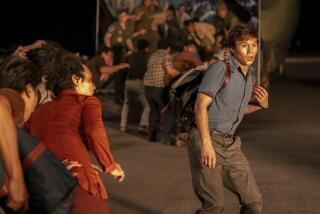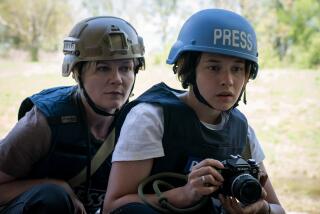Cambodia’s Past Haunts Its Present
PHNOM PENH, Cambodia — “This,” said Pen Phalla, standing in a schoolyard where the grass was neatly clipped and songbirds darted among tall palms, “is where they killed the intelligentsia. You know--teachers, doctors, the educated, people like that.
“Sometimes they beat them to death with shovels and hoes to save bullets. Or cut their throats. It just depended.”
She stepped into a classroom that had been partitioned into cells.
“That’s blood on the floor,” she said. “The bed’s original. You can see how they were chained to it before the interrogation and torture. The toilet’s over there.”
She pointed to a small metal box made in the United States to hold .50-caliber machine-gun bullets.
Pen Phalla, 45, who lost 11 members of her family to the homicidal reign of Khmer Rouge leader Pol Pot in 1975-79, speaks softly and lives with nightmares. Her hand isn’t steady enough to write.
She says she hates her job as a guide at Tuol Sleng Genocide Museum. The Cambodian equivalent of Auschwitz is a former concentration camp turned government-run museum. But somehow, for reasons she says she cannot quite fathom, she feels compelled to tell over and over again the story of how the very soul of a nation was ripped out.
Within hours of capturing Phnom Penh in April 1975, she said, the Khmer Rouge’s army of peasant guerrillas swarmed into this quiet neighborhood. They lugged barbed wire into the primary school, put up a double wall of corrugated iron and built a crude gallows. Over the next three years, about 15,000 Cambodians would be imprisoned here. Seven would survive.
Pen Phalla and millions of other Cambodians who lived through the terror of the Khmer Rouge misrule are doomed to remain forever haunted, their nerves rattled, the society traumatized.
“It is our fate,” Pen Phalla said matter-of-factly.
But for many Cambodians born after 1979, an eerie thing is happening. They have reconsidered their history and reached a conclusion that stuns their elders: They’d like to see Pol Pot’s men back in power, and they believe that the Vietnamese, not the Khmer Rouge, were responsible for the terror that claimed the lives of more than 1 million Cambodians.
“Cambodians never would have done that to Cambodians,” said student Hung Chhay, 16.
“But the Vietnamese, who hated us for years--yes, the killing’s something they could have done easily.”
Store clerk Lao Phan, 17, concurred: “The Khmer Rouge were Cambodian. They were peasants and farmers. They wanted good things for Cambodia. They were not killers.”
Teenagers Drawn to Alternative View
However chilling such revisionist history may be, the sentiments are widely shared among Phnom Penh’s teenagers.
They see the Khmer Rouge guerrillas as ultranationalists, uncorrupted by money and personal power, pure in their ideology, disciplined in their ability to keep unauthorized firearms off the streets--in other words, as the antithesis of what Cambodia has become since this country’s coup in July.
Some of the youths who believe this have even visited the Genocide Museum. They have seen the scaffold, the torture rack, the bloodied farm tools, the wooden tub for drowning people, the haunting gallery of young men and women, glassy-eyed with uncomprehending fear, who stare down from one classroom wall, photographed moments after they arrived at Tuol Sleng and the blindfolds were torn from their faces.
“Look straight into the camera” are the only words the teenage Khmer Rouge photographer, Nhem Ein, ever spoke to the victims. Ein photographed hundreds of people a day and processed the film at night, attaching the pictures to dossiers that genocide researchers at Yale University and other institutions have studied in recent years.
But if some young Cambodians have romanticized the Khmer Rouge, the members of Pen Phalla’s generation still teeter on the psychological edge.
For them, just the sound of an old mine being exploded by demolition experts is enough to empty the central market within minutes. And rumors that Western embassies would close--those reports spread quickly after the July coup--have been sufficient to bring panic to even the most stoic adults.
“Their sense of fear was palpable,” U.S. Ambassador Kenneth Quinn said after convening a meeting of his Cambodian staff in the violent aftermath of the coup. “It was the very same fear I saw in people’s eyes in Saigon in April 1975.”
The Brand of Fear That Won’t Go Away
It was the fear of abandonment, the knowledge that if the international community left, the population would be at the mercy of unwelcome victors, the kind the Khmer Rouge certainly once were.
The ambassador calmed his shaken staff only after raising his right hand and saying: “I swear to you I am not leaving, and if the embassy ever closes, I will not leave unless I can take all of you and your families with me.”
The trauma is manifesting itself in other ways too.
“The Khmer Rouge experience desensitized Cambodia,” one American resident said. “For example, someone was killed at our plant this year in a pretty horrible accident involving acetylene. I was amazed how little it affected the workers. They just sort of shrugged, as though to say, ‘Oh, well, another death.’ ”
Crime, domestic abuse and police brutality all have increased in Phnom Penh and appear to be symptoms of a wounded society.
Many Cambodians seem jittery and have lost the ability to concentrate, foreign residents say.
But ask a Cambodian what the Khmer Rouge legacy is and he is apt to remain silent. In fact, Cambodians hardly ever speak about their period of national darkness. It is as if their memory was selective, and that by ignoring or denying the past, they can hold the nightmares at bay.
The Beginnings of Nation’s Nightmares
Those nightmares had their genesis in the early 1960s, when the Khmer Rouge took form in the jungles of northern Cambodia.
Inspired by the teachings of Stalin and Mao Tse-tung and guided by an ultra-orthodox Communist ideology, the guerrilla army of peasant soldiers came to power in April 1975 after overthrowing the American-backed Lon Nol government in Phnom Penh.
Within days of taking control, the Khmer Rouge launched a grotesque social experiment to “purify” Cambodia and turn the country into one vast collective farm. All but a few thousand of Phnom Penh’s 2 million residents were marched to the countryside and put to work in labor camps.
Anyone who had been tainted by foreign influence--as, say, people who wore eyeglasses were considered to be--or anyone who had an education or held a government job was a candidate for execution.
“All the civilizing structures of society--family, community, religion, nationhood--were ruptured, and Cambodians have never been able to repair or replace them,” one European diplomat said. “It’s not surprising this remains a psychologically scarred country.”
One remarkable aspect of what happened in the aftermath of the Khmer Rouge nightmare is that nothing happened.
There were no avenging slayings, no individual or collective attempts to track down interrogators, torturers and executioners, no real interest in bringing Pol Pot or any of his henchmen to trial.
Pol Pot’s top deputy, Ieng Sary, was given amnesty last year--a move that caused no more comment in Cambodia than an afternoon rain shower--and scores of Khmer Rouge killers who broke with Pol Pot have been rewarded with top government posts. The prime minister himself, Hun Sen, is a former low-level Khmer Rouge commander.
Wide Indifference to a Trial for Pol Pot
Although Hun Sen and the co-prime minister he overthrew, Prince Norodom Ranariddh, signed a joint statement last summer supporting calls that the Khmer Rouge turn Pol Pot over to a court of international justice, no one took their declaration very seriously.
“They only did that to please the West,” a European diplomat said. “Most Cambodians, including Hun Sen and Ranariddh, don’t see any necessity in a trial. This is a society, like most in Asia, that considers debate and confrontation as dangerous and threatening. They’d rather just see the nightmare buried in history.”
Besides, in the Cambodian mind, mere mortals are not the ones who grant pardons and establish culpability. Everything a person does in life, good or bad, follows him like a shadow. Victims can forget, but they can’t pardon. That is left to a higher power.
So the Khmer Rouge is likely to remain a force in Cambodia as competing political parties trying to build a power base jockey for the movement’s support.
Hun Sen’s nervousness over Khmer Rouge defections to Ranariddh’s FUNCINPEC party, for example, was an underlying reason for his July coup.
As for the elusive Pol Pot, he is unlikely to ever answer for his crimes.
Pol Pot is now about 70 years old, enfeebled by malaria and living in a jungle camp near the northern town of Anlong Veng. He is a figure so universally reviled--except perhaps by the young Cambodians who have never learned their history--that his own brother, Saloth Seng, once said of him: “If he ever comes back to his native village, every living Khmer should be invited to cut him with a razor blade.”
Last July in Anlong Veng, his own Khmer Rouge colleagues denounced Pol Pot at a show trial reminiscent of a Cultural Revolution-style “struggle session” in China. He was stripped of his leadership and apparently placed under house arrest. His accusers said they would hand him over to an international tribunal but have since recanted.
In his first interview in 18 years, Pol Pot in October told Nate Thayer, an American journalist, that his “conscience is clear.”
“I came to carry out the struggle,” he said, “not to kill people. . . . You can look at me: Am I a savage person?”
Former Rulers’ Denial of Crimes
Pol Pot said the notorious Tuol Sleng Prison in Phnom Penh never existed, and he blamed the killings that took place in 1975-79 on Vietnamese agents.
His former senior aide, Ta Mok, a one-legged commander known as “The Butcher,” said during the same interview that claims that 1 million Cambodians died during the Khmer Rouge reign were exaggerated.
“But hundreds of thousands, yes,” he added.
“Never existed?” Pen Phalla asked incredulously when told of Pol Pot’s comments. “Tuol Sleng never existed? Does he think this is just a bad dream someone made up? That Cambodians by the hundreds weren’t killed right where I stand?
“I can tell you exactly how long the Khmer Rouge were in Tuol Sleng. Three years, eight months, 20 days and nine hours. That is a very, very long time.”
More to Read
Sign up for Essential California
The most important California stories and recommendations in your inbox every morning.
You may occasionally receive promotional content from the Los Angeles Times.










